
(a)
Interpretation:
The major product of the given reaction is to be predicted. A complete, detailed mechanism for the reaction is to be provided.
Concept introduction:
Halogen molecules undergo homolysis when irradiated with UV light to produce two radical atoms. Homolysis is the type of bond dissociation where each atom gets one of the bond electrons. An unpaired electron present in the radical of atom or molecule. It is a highly reactive and unstable species. This homolytic dissociation is called initiation.
Being reactive, a radical will react with other species present. This produces another radical, which can continue the reaction is a step called propagation. The reaction is generally branched as each initiation step produces two radicals. Propagation steps continue as long as radicals are present and may be terminated by a reaction between two radicals.
The reaction generally results in substitution, often of a hydrogen atom from the hydrocarbon skeleton. When there are distinct types of hydrogen atoms in the reactant, the hydrogen removed is one that will lead to the formation of the most stable radical. The relative stability of radicals changes in the same way as the stability of the carbocation. This decides the major product of the reaction.
Answer to Problem 25.40P
The major product of the reaction is
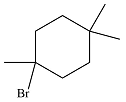
The complete mechanism of the reaction is
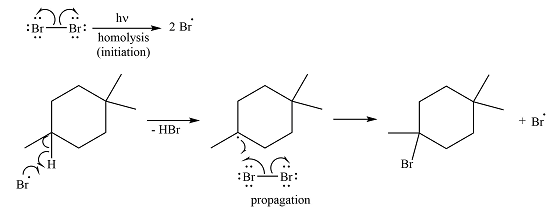
Explanation of Solution
The given reaction is

Irradiation of the reaction mixture with UV light leads to the formation of two bromine radicals through homolysis in the initiation step.

One of the bromine radicals reacts with the hydrocarbon and extracts a hydrogen atom (radical). There are three distinct types of – hydrogen atoms in the substrate; therefore three types of radicals can be produced in this step –
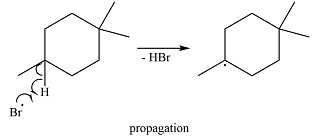
The
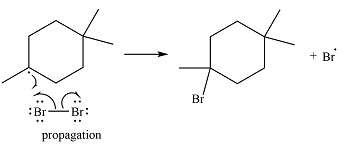
The bromine radical can continue the radical reaction chain or combine with another alkyl or bromine radical, in which case, the particular chain is terminated.
Thus, the complete reaction mechanism for the reaction can be drawn as

The major product of reaction will be

The major product of the reaction is determined on the basis of the stability of the alkyl radical produced after the initiation step.
(b)
Interpretation:
The major product of the given reaction is to be predicted. A complete, detailed mechanism for the given reaction is to be provided.
Concept introduction:
Halogen molecules undergo homolysis when irradiated with UV light to produce two radical atoms. Homolysis is the type of bond dissociation where each atom gets one of the bond electrons. An unpaired electron present in the radical of atom or molecule. It is a highly reactive and unstable species. This homolytic dissociation is called initiation.
Being reactive, a radical will react with other species present. This produces another radical, which can continue the reaction is a step called propagation. The reaction is generally branched as each initiation step produces two radicals. Propagation steps continue as long as radicals are present and may be terminated by a reaction between two radicals.
The reaction generally results in substitution, often of a hydrogen atom from the hydrocarbon skeleton. When there are distinct types of hydrogen atoms in the reactant, the hydrogen removed is one that will lead to the formation of the most stable radical. The relative stability of radicals changes in the same way as the stability of the carbocation. This decides the major product of the reaction.
Answer to Problem 25.40P
The major product of the reaction is a mixture of four isomers:
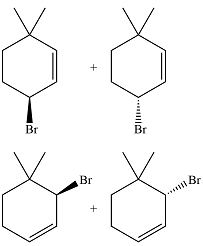
The complete mechanism for the reaction is
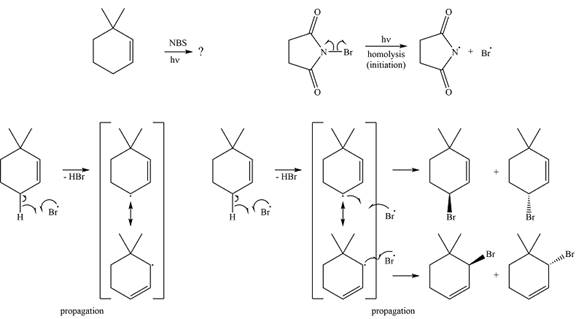
Explanation of Solution
The given reaction is
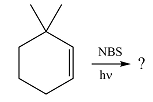
Irradiation of NBS (
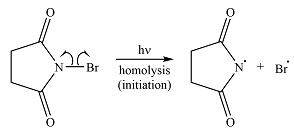
The bromine radical reacts with the substrate in the first of the propagation steps to produce the most stable radical. The most stable alkyl radical that can be produced on the extraction of a hydrogen atom is the allylic radical. Therefore, the hydrogen in the allylic position is extracted preferentially. The allylic radical is resonance stabilized.
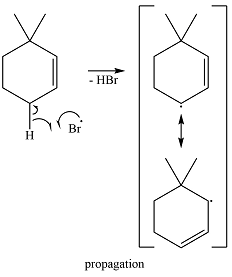
In the next propagation step, each resonance form of the allylic radical reacts with another bromine radical to produce the product. Since the cyclic radical is unsymmetric, each one produces a mixture of two isomers, giving a total of four isomeric products.
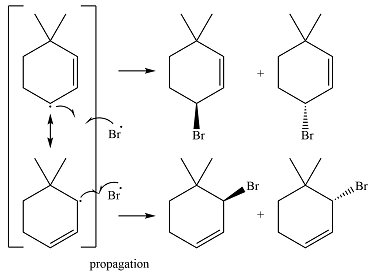
The complete mechanism for the reaction can be drawn as
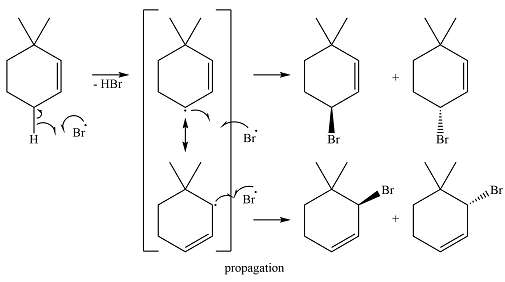
Thus the major product of the reaction is a mixture of four isomers.
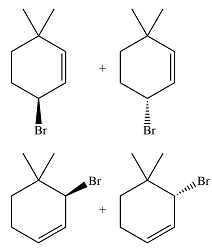
The major product of the reaction is determined on the basis of the stability of the alkyl radical produced after the initiation step.
(c)
Interpretation:
The major product of the given reaction is to be predicted. A complete, detailed mechanism for the given reaction is to be provided.
Concept introduction:
Under conditions that do not result in homolysis, halogen molecules, particularly chlorine and bromine, behave as electrophiles if electron-rich species such as
The addition is a two-step reaction. In the first step, a cyclic halonium intermediate is produced. In the second step, the halide ion formed in the first step acts as a nucleophile and adds to one of the carbons of the halonium intermediate to produce the vicinal dihalide product. Since the cyclic halonium intermediate is planar, the halide addition in the second step can occur from above or below the plane of the ring, giving a mixture of two isomers if the
Answer to Problem 25.40P
The major product of the reaction is a mixture of vicinal dibromo isomers.
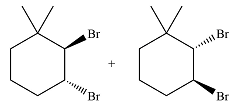
The whole mechanism of the reaction is

Explanation of Solution
The given reaction is

In the absence of UV irradiation, bromine will not undergo homolysis to produce radicals. Therefore, the reaction will be a simple electrophilic addition.
The
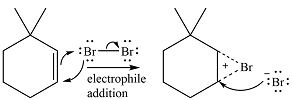
In the second step, the bromide ion produced in the first step will add to one of the carbons of the bromonium ring. Since the bromonium ring is planar, this addition can be from above or below the plane of the ring. This will lead to the formation of a mixture of isomers.

Thus, the whole mechanism for the reaction can be drawn as

The major product of the reaction will be
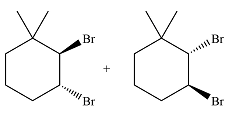
The major product of the reaction is determined on the basis of an electrophilic addition of the bromine molecule to the double bond.
Want to see more full solutions like this?
Chapter 25 Solutions
EBK GET READY FOR ORGANIC CHEMISTRY
- Identify the unknown compound from its IR and proton NMR spectra. C4H6O: 'H NMR: 82.43 (1H, t, J = 2 Hz); 8 3.41 (3H, s); 8 4.10 (2H, d, J = 2 Hz) IR: 2125, 3300 cm¹ The C4H6O compound liberates a gas when treated with C2H5 MgBr. Draw the unknown compound. Select Draw с H Templates Morearrow_forwardPlease help with number 6 I got a negative number could that be right?arrow_forward1,4-Dimethyl-1,3-cyclohexadiene can undergo 1,2- or 1,4-addition with hydrogen halides. (a) 1,2-Addition i. Draw the carbocation intermediate(s) formed during the 1,2-addition of hydrobromic acid to 1,4-dimethyl-1,3-cyclohexadiene. ii. What is the major 1,2-addition product formed during the reaction in (i)? (b) 1,4-Addition i. Draw the carbocation intermediate(s) formed during the 1,4-addition of hydrobromic acid to 1,4-dimethyl-1,3-cyclohexadiene. ii. What is the major 1,4-addition product formed from the reaction in (i)? (c) What is the kinetic product from the reaction of one mole of hydrobromic acid with 1,4-dimethyl-1,3-cyclohexadiene? Explain your reasoning. (d) What is the thermodynamic product from the reaction of one mole of hydrobro-mic acid with 1,4-dimethyl-1,3-cyclohexadiene? Explain your reasoning. (e) What major product will result when 1,4-dimethyl-1,3-cyclohexadiene is treated with one mole of hydrobromic acid at - 78 deg * C ? Explain your reasoning.arrow_forward
- Give the product of the bimolecular elimination from each of the isomeric halogenated compounds. Reaction A Reaction B. КОВ CH₂ HotBu +B+ ко HOIBU +Br+ Templates More QQQ Select Cv Templates More Cras QQQ One of these compounds undergoes elimination 50x faster than the other. Which one and why? Reaction A because the conformation needed for elimination places the phenyl groups and to each other Reaction A because the conformation needed for elimination places the phenyl groups gauche to each other. ◇ Reaction B because the conformation needed for elimination places the phenyl groups gach to each other. Reaction B because the conformation needed for elimination places the phenyl groups anti to each other.arrow_forwardFive isomeric alkenes. A through each undergo catalytic hydrogenation to give 2-methylpentane The IR spectra of these five alkenes have the key absorptions (in cm Compound Compound A –912. (§), 994 (5), 1643 (%), 3077 (1) Compound B 833 (3), 1667 (W), 3050 (weak shoulder on C-Habsorption) Compound C Compound D) –714 (5), 1665 (w), 3010 (m) 885 (3), 1650 (m), 3086 (m) 967 (5), no aharption 1600 to 1700, 3040 (m) Compound K Match each compound to the data presented. Compound A Compound B Compound C Compound D Compoundarrow_forward7. The three sets of replicate results below were accumulated for the analysis of the same sample. Pool these data to obtain the most efficient estimate of the mean analyte content and the standard deviation. Lead content/ppm: Set 1 Set 2 Set 3 1. 9.76 9.87 9.85 2. 9.42 9.64 9.91 3. 9.53 9.71 9.42 9.81 9.49arrow_forward
- Draw the Zaitsev product famed when 2,3-dimethylpentan-3-of undergoes an El dehydration. CH₂ E1 OH H₁PO₁ Select Draw Templates More QQQ +H₂Oarrow_forwardComplete the clean-pushing mechanism for the given ether synthesia from propanol in concentrated sulfurica140°C by adding any mining aloms, bands, charges, nonbonding electron pairs, and curved arrows. Draw hydrogen bonded to cayan, when applicable. ore 11,0 HPC Step 1: Draw curved arrows Step 2: Complete the intend carved Q2Q 56 QQQ Step 3: Complete the intermediate and add curved Step 4: Modify the structures to draw the QQQ QQQarrow_forward6. In an experiment the following replicate set of volume measurements (cm3) was recorded: (25.35, 25.80, 25.28, 25.50, 25.45, 25.43) A. Calculate the mean of the raw data. B. Using the rejection quotient (Q-test) reject any questionable results. C. Recalculate the mean and compare it with the value obtained in 2(a).arrow_forward
- A student proposes the transformation below in one step of an organic synthesis. There may be one or more reactants missing from the left-hand side, but there are no products missing from the right-hand side. There may also be catalysts, small inorganic reagents, and other important reaction conditions missing from the arrow. • Is the student's transformation possible? If not, check the box under the drawing area. • If the student's transformation is possible, then complete the reaction by adding any missing reactants to the left-hand side, and adding required catalysts, inorganic reagents, or other important reaction conditions above and below the arrow. • You do not need to balance the reaction, but be sure every important organic reactant or product is shown. + T G OH де OH This transformation can't be done in one step.arrow_forwardMacmillan Leaming Draw the major organic product of the reaction. 1. CH3CH2MgBr 2. H+ - G Select Draw Templates More H о QQarrow_forwardDraw the condensed structure of 3-hydroxy-2-butanone. Click anywhere to draw the first atom of your structure.arrow_forward
 ChemistryChemistryISBN:9781305957404Author:Steven S. Zumdahl, Susan A. Zumdahl, Donald J. DeCostePublisher:Cengage Learning
ChemistryChemistryISBN:9781305957404Author:Steven S. Zumdahl, Susan A. Zumdahl, Donald J. DeCostePublisher:Cengage Learning ChemistryChemistryISBN:9781259911156Author:Raymond Chang Dr., Jason Overby ProfessorPublisher:McGraw-Hill Education
ChemistryChemistryISBN:9781259911156Author:Raymond Chang Dr., Jason Overby ProfessorPublisher:McGraw-Hill Education Principles of Instrumental AnalysisChemistryISBN:9781305577213Author:Douglas A. Skoog, F. James Holler, Stanley R. CrouchPublisher:Cengage Learning
Principles of Instrumental AnalysisChemistryISBN:9781305577213Author:Douglas A. Skoog, F. James Holler, Stanley R. CrouchPublisher:Cengage Learning Organic ChemistryChemistryISBN:9780078021558Author:Janice Gorzynski Smith Dr.Publisher:McGraw-Hill Education
Organic ChemistryChemistryISBN:9780078021558Author:Janice Gorzynski Smith Dr.Publisher:McGraw-Hill Education Chemistry: Principles and ReactionsChemistryISBN:9781305079373Author:William L. Masterton, Cecile N. HurleyPublisher:Cengage Learning
Chemistry: Principles and ReactionsChemistryISBN:9781305079373Author:William L. Masterton, Cecile N. HurleyPublisher:Cengage Learning Elementary Principles of Chemical Processes, Bind...ChemistryISBN:9781118431221Author:Richard M. Felder, Ronald W. Rousseau, Lisa G. BullardPublisher:WILEY
Elementary Principles of Chemical Processes, Bind...ChemistryISBN:9781118431221Author:Richard M. Felder, Ronald W. Rousseau, Lisa G. BullardPublisher:WILEY





